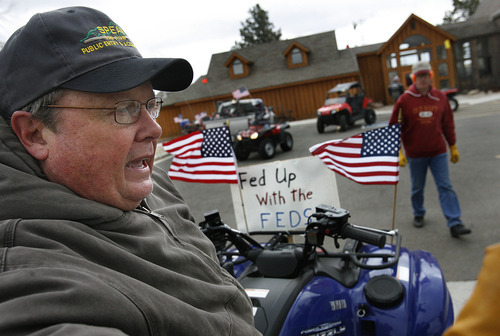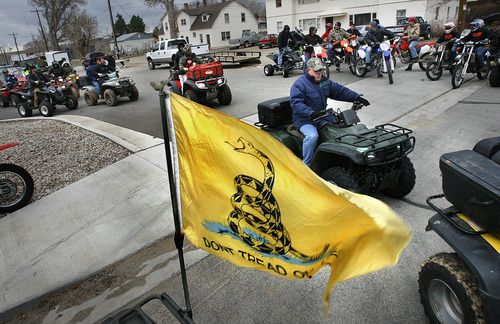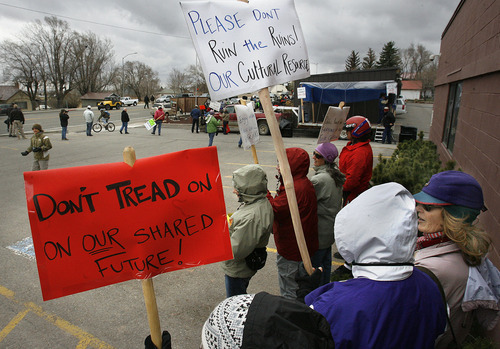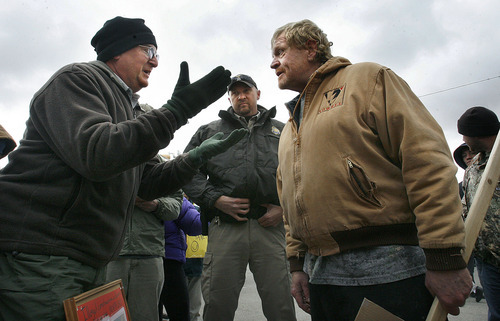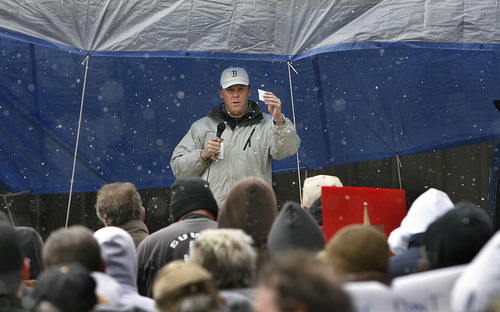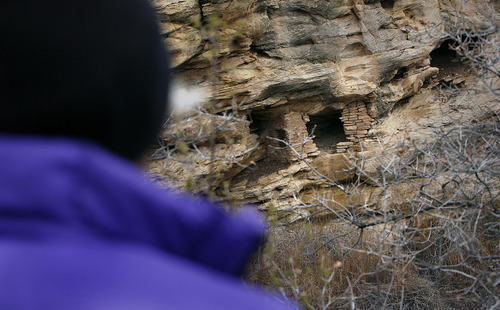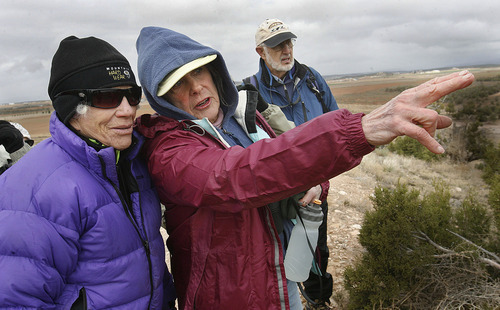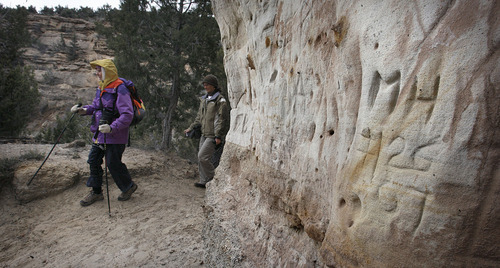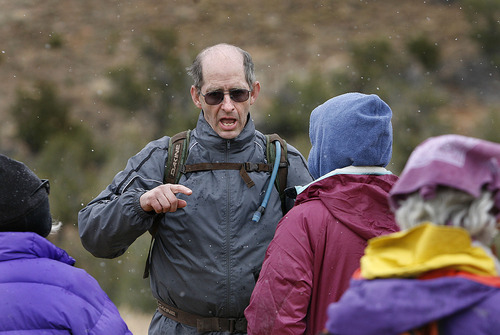This is an archived article that was published on sltrib.com in 2011, and information in the article may be outdated. It is provided only for personal research purposes and may not be reprinted.
Monticello • Four-wheelers, dirt bikes and Jeeps rumbled up Main Street to a protest rally outside federal land managers' offices here Saturday, where about 200 riders dismounted and cheered speakers demanding motorized access to Recapture Canyon and other parts of San Juan County.
Once there they met a quiet counterprotest by about 20 members and supporters of Great Old Broads for Wilderness — the environmental group that has watched the canyon for illegal use — and a regional U.S. Bureau of Land Management director who engaged them in a discussion about why the government closed an illegally built trail there in 2007.
Recapture Canyon is on the outskirts of Blanding and was open to cross-country motorized travel in 2005 when two Blanding men improved a seven-mile trail by adding hillside rock shoulders, fill dirt and pipe culverts to channel springs and runoff. They did it without a permit and this year a judge fined them $35,000. The BLM has since closed the trail after discovering damage to archaeological sites in the canyon.
San Juan County Commissioner Bruce Adams blamed that closure and others on wealthy environmentalists pressuring the government.
"We are offended and fed up with the fat-cat influence in San Juan County," Adams shouted as wind whipped plump snow flakes through the crowd.
Great Old Broads Director Ronni Egan later pointed out that the group with 4,500 members has a budget of $330,000 and none of the four full-time staff members makes more than $40,000. But the protesters also aimed their ire at the larger Southern Utah Wilderness Alliance, with placards imploring against "SUWA-cide."
Environmentalists frequently note that about 20,000 miles of designated motorized routes remain available across 11 million acres of southern and eastern Utah. Riders counter that those include dirt roads that aren't much fun to ride, and that they want to see the same rugged canyons and ancestral Puebloan Indian ruins that others prefer to reach by foot. The real fight is over the crevices that both hikers and off-roaders seek through single-track or 48-inch trails.
Some in the protest, organized by the San Juan Public Entry & Access Rights (SPEAR), lamented that urban Utah isn't watching as traditional desert playgrounds are closed. The BLM has increasingly refused to acknowledge older trails, they say.
"People on the Wasatch Front seem oblivious to what's happening in rural Utah," said Brent Johansen, a rider from Blanding. "They [the BLM and U.S. Forest Service] are closing roads just as fast as they can."
Great Old Broads members and supporters stood by holding signs that said "Take a hike," or other pedestrian-themed messages.
Marc Thomas of Moab attracted some scorn from the riders by holding up a poster showing photos of the erosion and disturbed ruins in Recapture Canyon.
"If you don't like motorized vehicles, then start walking," one man told him. "Buy a horse."
"I have a vehicle and I use it in appropriate places," Thomas responded.
"Who are you to decide what's appropriate?" his challenger said.
Some riders said it's arrogant to reserve lands for just the able-bodied, while the counterprotesters asked whether that argument logically leads to elevators plumbing the Grand Canyon. Blanding resident and Broads supporter Marilyn Boynton — whom some protesters tried to have ticketed for parking in a disabled space until they saw her truck's sticker — said she has bad knees now but wouldn't ruin the remote places she saw earlier in life just to reach them all now.
Discussions between the two sides were mostly quiet, though, and when voices rose federal agents stood between the debaters.
Shelley Smith, the BLM's Canyon Country director out of Moab, stood before the protest and explained that her agency legally had to take steps to protect archaeological resources. It's currently studying a county proposal to reopen the trail after protecting ancient sites and preventing soil erosion or damage to the canyon's stream, which supports beaver colonies.
Smith invited the protesters to come to monthly work sessions where interest groups are trying to hash out a plan for protecting resources. She said she's no constitutional law scholar and can't address their claims that the West is treated unfairly because of federal land ownership. But she said she can discuss ground-level solutions with them.
"I can't work with philosophy," she told them. "I can work real good with maps."
Some of the protesters, including county officials, said they appreciated her presence.
Later in the day both groups separately took hikes to the canyon floor — one to show how brazen the road builders had been, the other to assert that there had been no real environmental damage.
The supporters of motorized access joked about how terrible the damage had been. "Is this one of those $35,000 culverts?" one said while stepping over about an 8-inch-diameter pipe funneling water past the trail. "Better not step on it."
Alan Peterson, of Helper, said the illegal improvements that netted the fines should help the trail hold up against the hikers and mountain bikers who still use it. As he said it, a trio of horseback riders came by.
"Wouldn't culverts be good for a horse trail?" he asked.
The Great Old Broads, by contrast, said the pipes and rock berms proved that this trail was built with great effort and expense — not organically over time. The counterprotesters also noted points where seasonal rainfall has washed out the trail and fill that was placed in gullies, all leading to the stream. They oppose reopening the trail to vehicles, which they say would reward illegal activity, in addition to degrading the stream and trashing the ancient treasures.
At one point, a couple of access supporters passed the Broads on the trail, and a friendly debate ensued. Scott Wheeler, a rider from Price, asked why environmentalists opposed trail building in an area that hadn't officially closed. Egan answered that it was illegal.
"It really comes down to protection of resources," Egan said.
"We believe a bulldozed road is a resource," Wheeler said. It's better than encouraging riders to go wherever they will, he said.


